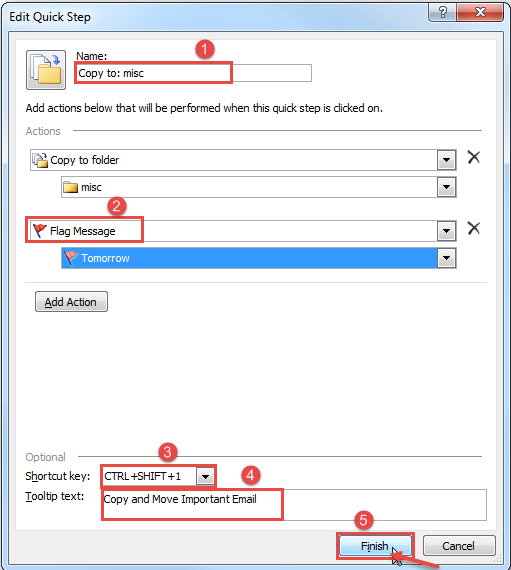

To create a new Quick Step, under the Outlook Home tab, in the Quick Steps group, click Create New. To change the icon for a Quick Step, click an icon next to the Name box at the top of the Quick Step Edit dialog box, click an icon to select it, and then click OK. You can also assign a keyboard shortcut to the Quick Step using the Shortcut key box, which is found at the bottom of the Quick Step Edit dialog box. These might include moving or copying a message to a particular folder, permanently deleting a message, assigning a category and more. Under Actions, change or add the actions you want this Quick Step to perform. To change an existing Quick Step, click on it and then click Edit. Click the arrow in the lower right corner of the Quick Steps box to bring up the Manage Quick Steps dialog box. Quick Steps are located under the Home tab in Outlook, toward the middle of the toolbar. For example, when doing an initial sort of my email inbox, I use a Quick Step to sort emails that require some action or follow-up on my part into a folder I’ve created called “Action.” In one click, I can move the message to the Action folder so I don’t have to go searching through my Inbox later for all of the messages that require my attention. Quick Steps can be used to perform repetitive tasks easily in Outlook when those tasks are not ones that can be made into Rules.


Some email management tasks are performed repetitively in Outlook, but are not appropriate for Rules, because they cannot be automated they require you to make a decision about what to do with the email. To add more conditions, actions, or exceptions to the rule, click the Advanced Options button, and then follow the rest of the instructions in the Rules wizard.

In the dialog box, select the conditions and actions you want to apply. To do so, simply right-click the message you want to base the rule upon, and click Create Rule. For example, you may want to create a folder for all messages that come from your bar association list-serve or from a particular client, and to have all of those messages automatically sort into those folders when they arrive in your inbox. This is helpful when you’re reading a message and you realize that you would like to create a rule that applies specifically to all messages with a particular subject line, or to all messages from a particular sender. You can also create a Rule directly from a particular message. To have this rule apply to all your e-mail accounts and inboxes, select the “Create this rule on all accounts” check box on the last page of the Rules wizard. Create the rule by specifying your own conditions, actions, and exceptions.Use a template with pre-specified actions and conditions and select the template you want.If you have more than one e-mail account, in the “Apply changes to this folder” list, click the inbox you want.On the Tools menu, click Rules and Alerts.In the Navigation pane (the column on the left side of the Outlook window that includes buttons for the Mail, Calendar, and Tasks views and folders), click Mail.
OUTLOOK QUICK STEPS TO ENTER TEXT HOW TO
Here’s how to create a rule from a template or from scratch: They’re easy to create and can be used to streamline common e-mail-related tasks. Outlook uses “rules” to automate common tasks. Two ways to help manage that avalanche of email if you use Outlook are using Rules and Quick Steps. Email has become a major clutter and productivity obstacle. Many have inboxes with thousands of messages in them. Although email is supposed to make communication quicker and easier, it can often complicate things instead.


 0 kommentar(er)
0 kommentar(er)
